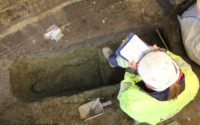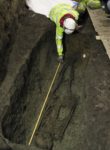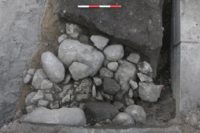 Last December, archaeologists began a secret excavation under City Hall Square in the heart of Copenhagen. It was kept scrupulously under wraps until February to give the team the opportunity to excavate what is thought to be the oldest burial ground in Copenhagen without risking contamination of the site by curious onlookers. Between December and the end of February, the remains of 20 men, women and children who lived around 1,000 years ago were unearthed just three feet under Denmark’s busiest square.
Last December, archaeologists began a secret excavation under City Hall Square in the heart of Copenhagen. It was kept scrupulously under wraps until February to give the team the opportunity to excavate what is thought to be the oldest burial ground in Copenhagen without risking contamination of the site by curious onlookers. Between December and the end of February, the remains of 20 men, women and children who lived around 1,000 years ago were unearthed just three feet under Denmark’s busiest square.
This is a highly significant find because by the known chronology, these individuals were the first Copenhagers, and archaeologists believe there are even more human remains to be found, at least another two layers of burials underneath the 20 already excavated. Since February, another 10 skeletons have been discovered. These 30 skeletons predate the legendary founding of the city by Bishop Absalon, who was said to have been given the site as a gift from King Valdemar in the 1160s, by at least a century, and upends the received wisdom that before Absalon built his castle Copenhagen was just a sleepy fishing village under the shadow of the neighboring urban center of Roskilde.
 The human remains are now at the Faculty of Health and Medical Sciences at the University of Copenhagen where they are undergoing further tests, including DNA analysis. Once the testing is done, they will be studied in more depth at the Natural History Museum of Denmark. This research will rewrite the history of Copenhagen’s earliest days, replacing the founding myth with a whole different category of information grounded in the biological data of the first residents of what would become Denmark’s capital city.
The human remains are now at the Faculty of Health and Medical Sciences at the University of Copenhagen where they are undergoing further tests, including DNA analysis. Once the testing is done, they will be studied in more depth at the Natural History Museum of Denmark. This research will rewrite the history of Copenhagen’s earliest days, replacing the founding myth with a whole different category of information grounded in the biological data of the first residents of what would become Denmark’s capital city.
 Meanwhile, the excavation at City Hall Square continues and has now added structural evidence to the new history of Copenhagen’s founding. Archaeologists have unearthed a stone foundation that they think belonged to the first church built in the city.
Meanwhile, the excavation at City Hall Square continues and has now added structural evidence to the new history of Copenhagen’s founding. Archaeologists have unearthed a stone foundation that they think belonged to the first church built in the city.
“If it is a church, it would further prove that Copenhagen was an established city at the start of the Middle Ages,” Lars Ewald Jensen, the archaeological head of the Museum of Copenhagen, told Videnskab.dk.
“You can have a burial site without an established city, because there needs to be more elements present before one can call it a city. But then again, you can’t have a city without having a church.” […]
The stone foundation bears witness to either a church being at the location at some point or a dyke that has split the graveyard into two sections.
“We hope we have discovered the foundation of a church building, in which case it would be a church that co-existed with St Clemens Church, which was excavated in 2008, or is older. Potentially, we have discovered the oldest church in Copenhagen,” Stine Damsbo Winther, an archaeologist with the Museum of Copenhagen, told Videnskab.dk.